Panama's Sarigua National Park
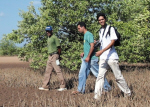
Panama’s well read La Prensa newspaper is running an 8 week Sunday feature on Panama’s National Parks. Written, photographed and designed by Alex Arosemena, the articles will present firsthand experience of the parks along with beautiful photography. Playacommunity was fortunate to secure permission to run a translation of the first Park featuring Sarigua National Park, which appeared in La Prensa on Sunday May 24, 2009.
Copyright of La Prensa. All rights reserved. All pictures and texts by Alexander Arosemena.
Sarigua National Park
Day 1
I arrived at Parita at four in the afternoon with Roberto Machazek at the wheel of the car from the Anam (Autoridad Nacional del Ambiente).
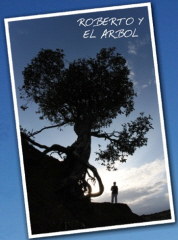 |
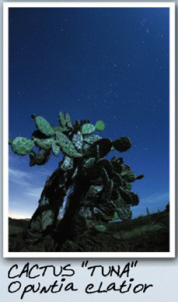 |
Before entering Sarigua I stopped at a little restaurant to fill a thermos with coffee, and bought roasted pork and corn fritters to go.
There are plenty of signs pointing the way to the park but the road is in bad shape because of the trucks that come and go from the shrimp plant within the park.
La Peña del Gato
We entered the national park by this road to a point near where we thought we could camp, at the Peña del Gato. The Peña del Gato is a mound with several large rocks and lots of vegetation. The sky was blue and the afternoon breeze was cool.
At five in the afternoon we began to explore the park with the hope of getting some good photos of a sunset which, unfortunately was blocked by clouds, a sign of a rainy season that would not abate. We stopped exploring and went back to our camp. At this time the breeze had died and a swarm of mosquitoes took advantage of this and began feeding on us.
Segovio Vega
The night had fallen when, out of the darkness, emerged Segovio Vega. Vega worked in Sarigua for 11 years, twenty-four hours a day as a guide by day and a guard at night. And, although he was let go from Sarigua two years ago, Vega continues to volunteer in the national park. He lives close and really enjoys showing Sarigua to visitors.
A Fierce Little Snake
Segovio told us that he had been watching us from the observation tower. “Now, I don’t want to scare you, but right here there is a fierce little snake that comes out of the mound to hunt. I think you need to camp way over there on the high ground away from the mound, where there aren’t any mosquitoes because they like the mound.”
“He makes sense. We need to pay attention to the old guys,” says Roberto.
I had my doubts. I wanted to take photos of a nocturnal animal and that I could only do near the mound….but, well, old people know their stuff.
Before moving we took a trip to the estuary, guided by Segovio. This is an area near a mangrove swamp, which floods with the tide.
 |
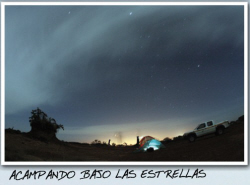 |
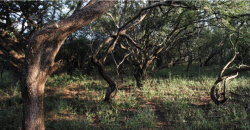 |
Tales of Coyotes
“One time, my son…” Vega told us, “…went out to the estuary to look for shrimp at about 11 at night, expecting to come back at 1. But, when he was in the water he saw on the shore 50 coyotes waiting for him, so he stayed in the water until 6 in the morning when the coyotes decided to leave.”
We followed the path through the brush and arrived at the recommended campsite. Aside from a few bats and a crazy cricket that got in my eye we did not see anything. As soon as we set up camp on the higher ground we felt a breeze and the mosquitoes disappeared.
We shared coffee with Mr. Vega. Later, after reminding us about our tour the next day, our friend stepped back into the cloak of the night.
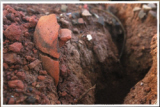 |
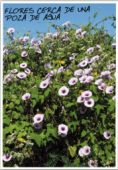 |
Starry Night
The moon came out and shone upon an almost hallucinatory landscape with dry logs emerging from the land like gigantic claws, while I remembered a movie that always scared me. When the wind came up it drove a tongue shaped cloud before revealing a million stars in the black sky. The temperature dropped and it was time to get into our sleeping bags.
Day 2
Native Pottery
Before sunup we walked back to the estuary to take pictures of a golden dawn. It was a fresh, breezy morning as the sky lightened to blue. At seven we met Vega to continue our exploration of Sarigua. He showed us pieces of ancient pottery, some with colorful designs. One can find shards of pottery throughout the park but there is one site with a treasure trove. “This is like an Indian garbage dump,” says the guide. “Visitors always want to take away something, but, imagine, if everyone took a shard of pottery, eventually there would be none left.”
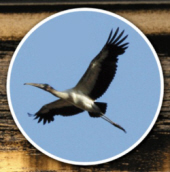 |
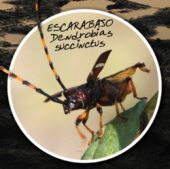 |
Tracks, Storks, and Mirages
We saw tracks of cats, dogs, and crocodiles. These are nocturnal animals and, as such, are difficult to catch a glimpse of. The shrimp plant has huge tanks, like small lakes. Near these were a lot of birds, including Caracara (a falcon-like version of a vulture) and American Storks, sort of a cross between a gallote (turkey vulture) and a white crane. We also saw white herons, pelicans, and an occasional frigate bird circling overhead, catching insects on the wind.
Roberto asked, “Can you see mirages here?” “Certainly,” said Vega, “sometimes from far away you think you see water and when you come near there isn’t any.”
The trek was long, about seven kilometers, and interesting. In some parts there were woods where the trees were twisted like a story from hell. In other areas there were strange mounds of earth, gardens of cactus, quartz laid out like a carpet, spiny bushes, huge rocks, and cotton plants. Later we came to a salt flat, a stretch of parched, cracked earth devoid of vegetation. There we found a few conches, remains of crabs, and a dried out starfish.
In the Mangrove Swamp
We continued across the salt flat toward the mangrove swamp. Little by little the cracked earth gave way to patches of mangrove until we were surrounded by vegetation and the muddy soil sucked at our boots.
We could not go any farther. We changed course and headed toward the “path of the armadillo,” where the shade was pleasant and the road paved. Finally, with the sun almost unbearable we arrived at the visitor center. It was 11 in the morning. We took advantage of a nice bath and got ready for the next national park, Cerro Hoya.
Click the pictures below to see full details
Copyright of La Prensa. All rights reserved. All pictures and texts by Alexander Arosemena.
**************************
More information about Sarigua National Park:
Sarigua National Park is located in the Herrera Province on the Azuero Peninsula. Only three hours by car from Panama City, along Panama’s Pacific Coast, Sarigua comprises 20,000 acres of mangrove swamp and an albina, an area produced by the salinization of land caused by deforestation and over grazing before it was created a National Park. Sarigua receives no more than 40 inches of rain a year. The park contains the remains of an 11,000-year-old village, the oldest known in Panama, making it one of the most important archeological sites in the country. To visit Sarigua you need a guide from ANAM, (500-0855).
La Prensa’s Parks articles will appear on the following schedule:
-May 24: Parque Nacional Sarigua, Parque Nacional cerro Hoya, Parque Nacional Santa Fe.
-May 31: Parque Nacional Darién.
-June 7: Parque Nacional Volcan Barú, Parque Nacional Marino Golfo de Chiriquí.
-June 14: Paque Nacional General de División Omar torrijos, Parque Nacional Altos de Campana.
-June 21: Parque Nacional Marino Isla Bastimentos, Parque Internacional La Amistad.
-June 28: Parque Nacional Camino de Cruces, Parque Nacional Portobelo.
-July 5: Parque Nacional Chagres, Parque Nacional Soberanía.
-July 12: Parque Nacional Coiba.


